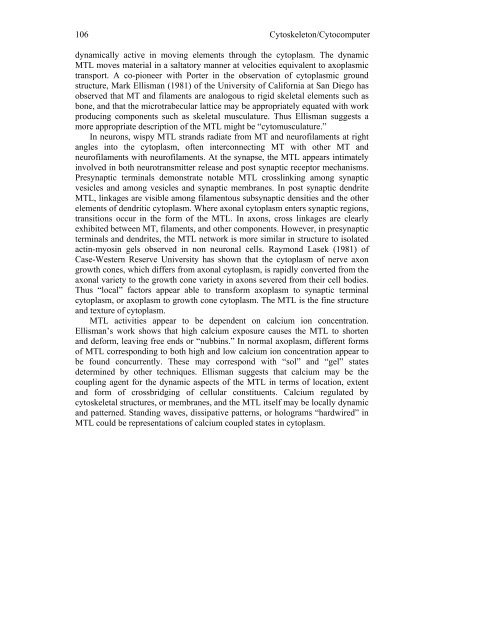ULTIMATE COMPUTING - Quantum Consciousness Studies
ULTIMATE COMPUTING - Quantum Consciousness Studies
ULTIMATE COMPUTING - Quantum Consciousness Studies
- No tags were found...
Create successful ePaper yourself
Turn your PDF publications into a flip-book with our unique Google optimized e-Paper software.
106 Cytoskeleton/Cytocomputer<br />
dynamically active in moving elements through the cytoplasm. The dynamic<br />
MTL moves material in a saltatory manner at velocities equivalent to axoplasmic<br />
transport. A co-pioneer with Porter in the observation of cytoplasmic ground<br />
structure, Mark Ellisman (1981) of the University of California at San Diego has<br />
observed that MT and filaments are analogous to rigid skeletal elements such as<br />
bone, and that the microtrabecular lattice may be appropriately equated with work<br />
producing components such as skeletal musculature. Thus Ellisman suggests a<br />
more appropriate description of the MTL might be “cytomusculature.”<br />
In neurons, wispy MTL strands radiate from MT and neurofilaments at right<br />
angles into the cytoplasm, often interconnecting MT with other MT and<br />
neurofilaments with neurofilaments. At the synapse, the MTL appears intimately<br />
involved in both neurotransmitter release and post synaptic receptor mechanisms.<br />
Presynaptic terminals demonstrate notable MTL crosslinking among synaptic<br />
vesicles and among vesicles and synaptic membranes. In post synaptic dendrite<br />
MTL, linkages are visible among filamentous subsynaptic densities and the other<br />
elements of dendritic cytoplasm. Where axonal cytoplasm enters synaptic regions,<br />
transitions occur in the form of the MTL. In axons, cross linkages are clearly<br />
exhibited between MT, filaments, and other components. However, in presynaptic<br />
terminals and dendrites, the MTL network is more similar in structure to isolated<br />
actin-myosin gels observed in non neuronal cells. Raymond Lasek (1981) of<br />
Case-Western Reserve University has shown that the cytoplasm of nerve axon<br />
growth cones, which differs from axonal cytoplasm, is rapidly converted from the<br />
axonal variety to the growth cone variety in axons severed from their cell bodies.<br />
Thus “local” factors appear able to transform axoplasm to synaptic terminal<br />
cytoplasm, or axoplasm to growth cone cytoplasm. The MTL is the fine structure<br />
and texture of cytoplasm.<br />
MTL activities appear to be dependent on calcium ion concentration.<br />
Ellisman’s work shows that high calcium exposure causes the MTL to shorten<br />
and deform, leaving free ends or “nubbins.” In normal axoplasm, different forms<br />
of MTL corresponding to both high and low calcium ion concentration appear to<br />
be found concurrently. These may correspond with “sol” and “gel” states<br />
determined by other techniques. Ellisman suggests that calcium may be the<br />
coupling agent for the dynamic aspects of the MTL in terms of location, extent<br />
and form of crossbridging of cellular constituents. Calcium regulated by<br />
cytoskeletal structures, or membranes, and the MTL itself may be locally dynamic<br />
and patterned. Standing waves, dissipative patterns, or holograms “hardwired” in<br />
MTL could be representations of calcium coupled states in cytoplasm.






